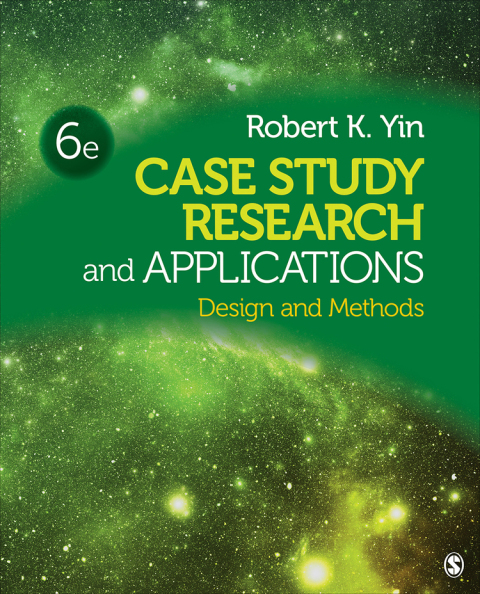Description
Efnisyfirlit
- Foreword
- Preface
- Acknowledgments
- About the Author
- Chapter 1 • Getting Started: How to Know Whether and When to Use the Case Study as a Research Method
- Being Ready for the Challenge, and Setting High Expectations
- Comparing Case Studies With Other Social Science Research Methods
- Relationships Among the Methods: Not Hierarchical
- When to Use the Different Methods
- Variations in Case Studies, but a Common Definition
- Definition of the Case Study as a Research Method
- Variations in Case Studies as a Research Method
- Addressing Traditional Concerns About Case Study Research
- Summary
- Notes to Chapter 1
- Chapter 2 • Designing Case Studies: Identifying Your Case(s) and Establishing the Logic of Your Case Study
- General Approach to Designing Case Studies
- Definition of Research Designs
- Components of Research Designs
- The Role of Theory in Research Designs
- Theory Development
- Illustrative Topics for Theories
- Using Theory to Generalize From Case Studies
- Summary
- Criteria for Judging the Quality of Research Designs
- Construct Validity
- Internal Validity
- External Validity
- Reliability
- Summary
- Case Study Research Designs
- What Are the Potential Single-Case Designs (Types 1 and 2)?
- What Are the Potential Multiple-Case Study Designs (Types 3 and 4)?
- Modest Advice in Selecting Case Study Designs
- Single- or Multiple-Case Designs?
- Closed or Adaptive Designs?
- Mixed-Methods Designs: Mixing Case Studies With Other Methods?
- Notes to Chapter 2
- Application #1: An Exploratory Case Study: How New Organizational Practices Become Routinized
- Application #2: Defining the “Case” in a Case Study: Linking Job Training and Economic Development Initiatives at the Local Level
- Application #3: How “Discovery” Can Occur in the Field: Social Stratification in a Midsized Community
- Chapter 3 • Preparing to Collect Case Study Evidence: What You Need to Do Before Starting to Collect Case Study Data
- The Case Study Researcher: Desired Skills and Values
- Asking Good Questions
- Being a Good “Listener”
- Staying Adaptive
- Having a Firm Grasp of the Issues Being Studied
- Conducting Research Ethically
- Preparation and Training for a Specific Case Study
- Protecting Human Subjects
- Training to Do the Case Study
- The Case Study Protocol
- Overview of the Case Study (Section A of the Protocol)
- Data Collection Procedures (Section B of the Protocol)
- Protocol Questions (Section C of the Protocol)
- Tentative Outline for the Case Study Report (Section D of the Protocol)
- Screening the Candidate Cases for Your Case Study
- The Pilot Case Study
- Selection of Pilot Cases
- Scope of the Pilot Inquiry
- Reports From the Pilot Cases
- Summary
- Notes to Chapter 3
- Chapter 4 • Collecting Case Study Evidence: The Principles You Should Follow in Working With Six Sources of Evidence
- Supporting Textbooks
- Supporting Principles
- Six Sources of Evidence
- Documentation
- Archival Records
- Interviews
- Direct Observations
- Participant-Observation
- Physical Artifacts
- Summary
- Four Principles of Data Collection
- Principle 1: Use Multiple Sources of Evidence
- Principle 2: Create a Case Study Database
- Principle 3: Maintain a Chain of Evidence
- Principle 4: Exercise Care When Using Data From Social Media Sources
- Summary
- Notes to Chapter 4
- Application #4: Doing Interviews in the Field: Citizens on Patrol
- Application #5: Making Field Observations: First Day in an Urban Neighborhood
- Application #6: Assembling a Question-and-Answer Database: A Case Study of a Community Organization
- Chapter 5 • Analyzing Case Study Evidence: How to Start Your Analysis, Your Analytic Choices, and How They Work
- An Analytic Strategy: More Than Relying on Analytic Tools
- Need for an Analytic Strategy
- Four General Strategies
- Five Analytic Techniques
- 1. Pattern Matching
- 2. Explanation Building
- 3. Time-Series Analysis
- 4. Logic Models
- 5. Cross-Case Synthesis
- Pressing for a High-Quality Analysis
- Summary
- Notes to Chapter 5
- Application #7: Using a Case Study to Compare Directly Competing Rival Hypotheses: Whether Military Base Closures Produce Catastrophic Economic Impacts or Not
- Application #8: A Nutshell Example of an Explanatory Case Study: How a Federal Award Affected a University Computer Department
- Application #9: An Explanatory Case Study: Transforming a Business Firm Through Strategic Planning
- Chapter 6 • Reporting Case Studies: How and What to Compose
- Having a Flair
- What “Composing” Covers
- Audiences for Case Study Research
- Potential Audiences
- Orienting Case Study Research to an Audience’s Needs
- Communicating With Case Studies
- Varieties of Case Study Compositions
- Compositional Formats
- Illustrative Structures for the Substance of Your Case Study
- Methods and Research Literature Portions of a Case Study
- Case Studies as Part of Larger, Mixed-Methods Studies
- Procedures in Composing a Case Study
- When and How to Start Composing
- Case Identities: Real or Anonymous?
- Reviewing the Draft Case Study: A Validating Procedure
- What Makes an Exemplary Case Study?
- The Case Study Must Be Significant
- The Case Study Must Be “Complete”
- The Case Study Must Consider Alternative Perspectives
- The Case Study Must Display Sufficient Evidence
- The Case Study Must Be Composed in an Engaging Manner
- Notes to Chapter 6
- Application #10: A Multiple-Case Study Integrating Qualitative and Quantitative Data: Proposal Processing at 17 Universities
- Appendix A. A Note on the Uses of Case Study Research in Psychology
- Appendix B. A Note on the Uses of Case Study Research in Evaluations
- Application #11: An Evaluation Case Study: Evaluation of a Community Coalition’s Campaign
- Brief Glossary of Terms Directly Related to Case Study Research
- References
- Author Index
- Subject Index






Reviews
There are no reviews yet.